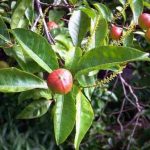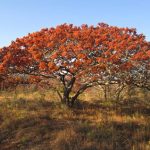TREE LIFE
August 1999
MASHONALAND CALENDAR
Saturday 7 August. Conifer walk.
Tom is out of the country so something different has been organised for this month’s walk. Lyn Mullin has kindly arranged to lead us on a conifer walk at the Forest Research Centre in Highlands. We will meet at 10 a.m. in the car park of the centre, (from Harare left off the Enterprise Road into Orange Grove Drive and then first left into the Centre’s entrance). Lyn has prepared diagrams, maps and lists of species for the walk.
Sunday 22 August. N.B. A week later than normal because of the public holidays.
Our trip this month is a return visit to the very interesting Pote Valley in the Bindura/Shamva area, this time to the property of Mr. and Mrs. Bishop. On the neighbouring farm on a previous outing some not so common species were seen, which did puzzle us somewhat, (like Schrebera trichoclada). An interesting day is anticipated.
Sunday 1 August. We have been invited to join the Aloe and Cactus Society on their visit to Martha and Jonathan Gaisford on their farm at Concession at 10 a.m. for rocky kopjies, rock art, aloes and trees.
Saturday 28 August. At 2.30 p.m. in the Biology lecture theatre at St. George’s College, (next to the Chapel) Werner and Virginia Fibeck will be presenting a talk illustrated with beautiful slides. The subject is indigenous orchids in Zimbabwe and the emphasis will be on the ecological characteristics or our orchids. Tea will be served during a midway break.
Tuesday 2 September. Back to summer time Botanic Walks.
MATABELELAND CALENDAR
Sunday 1 August. Leopard Rock near Khami Dam. Meet at Girl’s College car park (Pauling Road entrance) at 8.15 for 8.30 sharp departure.
Sunday 5 September. Matopos, Nswatugi area, but as Nat Park fees have just gone up we may need to revise this to an adjacent, free area. Meet at Girl’s College car park (Pauling Road entrance at 8.15 for 8.30 sharp departure.
RESULTS OF THE TREE SOCIETY QUESTIONNAIRE
Everyone attending the A.G.M. was asked to complete a questionnaire. The object of the questionnaire, which was based on one used by the Bulawayo branch, was to try and find out, in the light of our declining membership, whether members were satisfied with the Society or not.
The purpose of this short note is to summarize the main points of the replies. More precise details are available from me should any member be interested.
In considering the results, the very small sample (17 replies) should be borne in mind.
Types of outing. Under this heading, the questions were designed to find out whether members were happy with the outings offered by the Society. Generally, the responses suggested that this was so, with all the members who replied indicating that they were happy with the three events offered each month by the society (i.e. the Botanic Garden walk, the main outing and my walk). The two most important things that members looked for on outings were: to find out more about tree species in general (20%) and to visit an interesting, diverse area (19%). The social option scored the lowest.
Venues. The question asked was unfortunately vague but the majority indicated that they preferred visiting private farms with other areas such as national parks scoring lower. A few members suggested locations for the Society to visit.
Membership. On being asked whether the Society has a declining membership and participation at meetings, 64% said No. In fact, the question was poorly worded, since the Society does have a declining membership, but attendance at meetings may not be declining. However, all but one member thought we needed new members and the following suggestions were put forward as to how membership could be increased.
- i) Combined outings with other groups (e.g. Aloe Society) (60%)
- ii) Inclusion of social occasions (e.g. slide/film shows) (40%)
Many useful suggestions were made as to how advertising/publicity could be increased and these will be pursued by the Committee.
Objectives of the society. A clear majority (73%) indicated they would like to see the Society becoming more active in advocacy, such as tree planting days, education, conservation activities, etc.
I also slipped in a question as to whether the Society should extend its activities to the herbaceous flora of Zimbabwe and a clear majority (87%) supported this.
Finally, would like to thank all those who completed the questionnaires. The results have given the Committee some ideas to develop. We also have to decide whether to extend the whole exercise to all members.
-Mark Hyde
Christon Bank – 16 May 1999
After an A.G.M. it’s my usual practice to go into ‘neutral’, so thank you Mark for allowing me to use your notes.
Since few cattle are around in this area to feed on the Desmodium sp., this exotic has become a problem, so in between wrenching handfuls of seeds from socks and limbs, not much identification of plants took place. However, some interesting features of tree bark were noted and hopefully will provide additional ‘help files’ for your field identification.
Concerning ourselves with the more common species and starting with Pterocarpus rotundifolius subsp. rotundifolius, this is the usual one we see around Mashonaland and produces a grey and sometimes rough textured bark, splitting into shallow blocks or strips on mature trees. In common with most Pterocarpus sp. a red exudate appears where the bark has been damaged and as mentioned in previous articles in Tree Life has a wide variety of uses in traditional medicine.
Combretum molle an old favourite which is pretty nondescript when leafless but has a bark that splits into ‘blocks’ which eventually flake away.
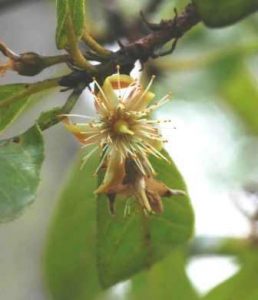
Monotes glaber. Photo: Bart Wursten. Source: Flora of Zimbabwe
Monotes glaber generally a most distinctive tree and in the short period they are leafless the erect appearance of the tree is often a good guide. The bark is grey in colour, rough in places with fine vertical cracks and smooth on the younger branches.
Pittosporum viridiflorum, more common around watercourses and kopjies and the smooth grey bark has a distinct feature of red/brown lenticels scattered over the entire bark surface.
Brachystegia glaucescens, the Mountain Acacia, fire sensitive and thus restricted to hills and kopjies. It is one of the most distinctive trees in the country, even when leafless, and the pale grey bark flakes in elliptical patches leaving a reddish underbark.
Brachystegia boehmii, Mufuti is another well-known species but differs vastly from the above as it is a woodland species with a rough dull grey bark splitting in irregular vertical cracks. It is tolerant of most grass fires.
Back at the car park, Lyn Mullin pointed out two species of the Pinus family, firstly the better known Pinus patula, widely planted as an ornamental tree around Harare and is the main plantation species in the commercial forest operations in the Eastern Districts. It is native to Mexico but tolerates Zimbabwe’s climate well. The bark is reddish and rough at the bole, becoming smooth on younger branches while the needles are green and droop. The other species Pinus roxburghii, which is native to the Himalayas, is very different in appearance; it has an erect habit with a grey coarse bark, stiff yellowish coloured needles and large cones are produced. Although not as widely planted as Pinus patula it is quite common around Harare with a number planted along the road leading to Cleveland Dam.
Many thanks to those who brought cakes and eats and also to Lyn for the additional information about the Pines.
-Andy MacNaughtan
20 June 1999 – NEAR SELOUS
The walk this month was held at Helen Monaghan’s Sivundazi Farm, near Selous. There were perhaps about fifteen members, the warning of the condition of the road might have put people off, but in fact, it was no worse than many roads in Harare. A splendid tea was served on the verandah, after which we drove through cotton fields, Brachystegia boehmii and Colophospermum mopane woodland to the dam. A lovely sight awaited us in the form of Water lilies, herons and cormorants on fence posts and stumps. Balm for the townsfolk.
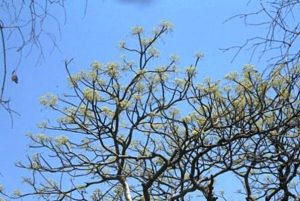
Kirkia acuminata. Photo: Mark Hyde. Source: Flora of Zimbabwe
The walk along the ridge above the river bed and the scramble down to the river and back to the foot of the dam wall was led by Mark Hyde. On the ridge the notable trees were Kirkia acuminata and Acacia polyacantha, Lonchocarpus capassa and Diospyros mespiliformis.
Autumn colours were provided by foliage of Zanha africana, Croton gratissimus. There were numerous Strychnos potatorum with their small poisonous black fruit, and Ziziphus mucronata, some with red berries. Of the scrambling bushes, the Grewia flavescens with their square stems, were the most easily recognised. Rhoicissus revoilii was unusual, although the books say it is widespread in the country. Commiphora africana caught the eye with its smooth greenish fissured bark and was recognisable without leaves.
Rob Burrett found a flat-topped rock with three deep hemispherical grinding holes, and explained how gold ore was crushed on the flat surface and ground in the depressions. The gold was then scraped off the sides of the hole, or recovered by panning the residue. All very interesting and inspires one to read Rob’s book on prehistory!
Scrambling half way down the ridge, the prize of the day was a large number of Synadenium sp. Mark would not venture a specific name, but said it was unusual in such numbers in this locality. Round fleshy branches, smooth green bark, copious latex produced when broken. Reputed to be very irritant. The leaves were clustered at the ends of branches with small tri-lobed fruit on willowy sprays.
A creeper Ruspolia hypocrateriformis, far out of range, had been in flower six weeks previously. Red flowers, but now very nondescript.
The scramble ended in a narrow belt of riverine forest. There were numerous Mimusops zeyheri and some were very large specimens. There were a variety of trees and shrubs, which made the climb back over the rocks to below the dam wall both fascinating and strenuous. A small Combretum erythrophyllum that lived up to its specific name by displaying orange/red leaves and some fine Ficus sycomorus were encountered.
Back to the house for lunch under the large trees in the garden. For dessert we sampled Cucumis metuliferus, a dangerous looking spiny cucumber, found on creepers commonly in riverine bush, and in the environs of Harare to which they have escaped.
After lunch there was an extended tour of Helen’s herb garden, admiring numerous varieties of various herbs – culinary and medicinal – including such unusual plants as stinging nettles. Drinking in a variety of scents we were enthralled by accounts of medicinal uses and experiences of cures achieved with herbs – a fascinating aspect of plant uses that many had not thought much about.
A delightful and worthwhile day ended with many members taking home herbs to plant. Very many thanks to Helen for her warm hospitality.
-John and Dagmar Lawrence
NYARUPINDA CATCHMENT
Subsequent to my letter in February Tree Life No. 229, we made a sudden compassionate visit to England. After the beautiful obsequies, the winter countryside awaited us. In Hertford, a hoarfrost whitened and crisped grass and dwarf conifers, sleet overnight in Suffolk looked like snow on the lawns but melted on gravel paths. On 1st March heavy seas lashed the coast as we battled along the Front at Hastings in the teeth of a westerly gale. This was the first of their March Winds. We had returned to Zimbabwe before their April showers.
At Tinto near Raffingora, April showers ended on 8th April with 10 mm that brought the 1998/99 rainfall total to 1061 mm. More than 42 inches – very pleasing.
In Hertford, where we stayed, sixteen children frequented the home of their grandparents; here is a quote from one of their books by Margaret Mahy “The Haunting of Miss Cardamom”. ‘Miss Cardamom found she was walking behind a very strange shaggy woman who looked as if she had bark for skin. As for her dress, it was all ragged at the bottom, with lots of bright threads hanging down’. Did this shaggy person add a nuance of Patchouli to complement her image? Was Miss Cardamom aware of a warm fragrant trail of freshly cut green wood…? Strange to relate, Patchouli Perfume Oil was a last moment purchase at Gatwick Airport’s Body Shop. A word about this product. It is distilled from dried leaves of Pogostemon cablin that belongs to the mint, basil and lavender family Lamiaceae. It is a Philippine Island shrub cultivated in India and Malaysia where this perfume is popular. Chemically the oil is a resin fixative akin to Sandalwood (a wood aromatic, Santalum album), Vetiver grass and myrrh, used for blending fragrances. Recently when enquiring about Patchouli at Westgate the saleslady said it reminded her of compost.
Indigenous Wood Collection at Tinto
Some are flat sawn on one side, others sawn to reveal the planes of wood, some are short boards i.e. of Mukwa and Kirkia acuminata, small parquet of Zimbabwe Teak, segments of rod less than 2” diameter, others are lengths of pole more than 2” across. Fresh cut green wood is kept indoors in a cool place for approximately a year to season, so that cracks or splitting; (the separation of fibres) is avoided. Wood shrinks from the heart outwards. The technical name for cracks in timber is shakes; these may be radial, starting from the bark or circumference. Heart shakes radiate from the centre or heart of a log; when the latter criss-cross they are star shakes. Cup shakes follow the growth or annual rings. The latter are not common in this collection of samples because their diameter is small, or they are species that have no growth rings, e.g. Lannea discolor, Parinari, Faurea sp.; or poorly defined rings e.g. the Brachystegia and Gardenia sp.
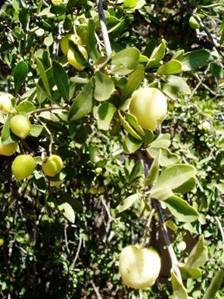
Cassine transvaalensis. Photo: Mark Hyde. Source: Flora of Zimbabwe
Shake free samples which have stood the test of time are displayed on 845 cm of shelves under thatched eaves with a southwest aspect. This is far from ideal but our family, friends and visitors see them, comment, offer information, or are prompted to find another one to add to them. In this way came Cassine transvaalensis, a rich brown wood from Macheke, Berchemia came my way, 2 off-cuts of Red Ivory ex Meg C. P., and a small plank of Bird Plum from Ian Kempthorne; the slice of Purple-wood Dalbergia nitidula came from the du Plessis family at Bakwe farm, Raffingora.
More than 120 samples on the shelves occupy an average width of 7 cm placed side by side. 21 of them could be considered stable under these conditions. Periodically they are sprayed with insecticide, which may also discourage moulds. It takes a week of daylight hours to remove weather stains on the outside-facing ends using two grades of silicon carbide waterproof paper. Each national number is checked for legibility. So as not to undo all this tedious labour a water-repellent detachable shade cloth curtain will be fitted from another shelf above the collection.
National numbers of trees (21 numbers supplied. Ed.) are listed in numerical order in “Common Trees of the Central Watershed Woodlands” by Robert Drummond.
A Beekeeper Tree Day took place on 22 May Kashwao farm, Mutorashanga. Meg Coates Palgrave gave an introductory talk; the following points were noted: shades of red frequently occur in the growing points of Southern Africa’s indigenous trees e.g. Ochna sp., figs, Diospyros kirkii and the famous Msasa and Mufuti; their new red leaves reflect the healing red rays of the spectrum keeping the leaf cool so that it avoids sun scorch. These red leaves take 25 days to turn green. Msasa trees at Nyanga have more leaflets than those in the middleveld. During the woodland walk between a huge wall of granite and the dam Mr. John Walker drew our attention to Commiphora mossambicensis close to the path, saying that honey bees use Commiphora species as a source of resin for ‘bee-glue’, called propolis, for making their hives. Their proboscis probes the bark and collects the exudate.
Browsing in England
Arborist is not in the Readers’ Digest Oxford Complete Wordfinder; it appeared in the journal of the Royal Horticultural Society as in the U.K, Arborists’ Tree Record Office, a tree register of the British Isles. Here it is apt to quote ‘The British Isles have about 100 woody plants of which only about 40 are trees. Rhodesia has over 1200 indigenous woody plants over 2 metres high, 730 are trees’. The writer of these words is likely to be R.B. Drummond – it appeared in 1974. Perhaps it is in the collectors’ item The Rhodesian Book of the Road? Could Mr. Drummond tell us how many trees there are now?
Overseas there is an Arborsonic Decay Detector, which is a device used by local authorities, The National Trust, Commercial Timber Growers and the Royal Parks of London. This is tree body scanning with radio waves and a strong magnetic field – ultrasound. It will help tree surgeons to preserve valuable and historic trees into the next millennium.
In the Shooting Times there was an advertisement offering tuition in Modern Latin. It listed the advantages of this course; the final words were ‘Veni, Vidi, Intellexi’. There is a blissful small handbook called Plant Names Simplified – their Pronunciation, Derivation and Meaning. The co-authors are A.T. Johnson & H.A. Smith. It was published by Hamlyns in 1972 and has been reprinted many times. Now printed by Print Logic Ltd. Hereford. It cost £7.99 in England. This is a lot of Zimbabwe Dollars but worth every one of them. This little dictionary was updated and enlarged in 1986; it is the size of a Shearly Cripps diary.
The next letter will be about Charcoal Trees and more English browsing…
-Benedicta Graves
In an interesting note Pam Wilson writes, ‘To confirm that Dovyalis zeyheri gives off a smell of carrion please read CP page 641.
Whilst walking in my arboretum I asked my gardener what the awful smell was and he pointed to the Dovyalis.’
Safe as Houses
Calcutta’s House Sparrows may use naturally occurring anti-malarials, writes Adrian Barnett. In an area where Krishnachura Trees Caesalpinia pulcherrima are uncommon, Sudhim Sengupta and colleagues at Calcutta’s Centre for nature Conservation and Human Survival found quinine-rich Caesalpinia leaves heaped in House Sparrow nests. The sparrows not only promptly replaced the leaves if they were removed but also ate them. Previously, sparrows lined their nests with leaves of Neem trees Azadirachta indica, containing high concentrations of insect-repellent compounds. The switch to Caesalpinia leaves coincided with a malarial outbreak in the city, and the biologists suggest that these leaves may ward off mosquitoes carrying malaria and kill malarial parasites (Emu, vol. 97. Pp 248-9).
April 1999 BBC Wildlife.
ANDY MACNAUGHTAN CHAIRMAN


